|
Meet Mother Ayahuasca
Many Westerners travel to Peru to drink a powerful vision-inducing potion. Keith Rozendal investigates their shamanic tourist trips. Illustrated by Emily Nisbet.
Diana’s family provided many middle-class comforts: private schooling, a university education, travel, healthy food, and spacious housing. Nearing 40, she gave up some of this security to take a journey to a hut in Peru’s upper Amazon, her launching pad away from ordinary reality altogether.
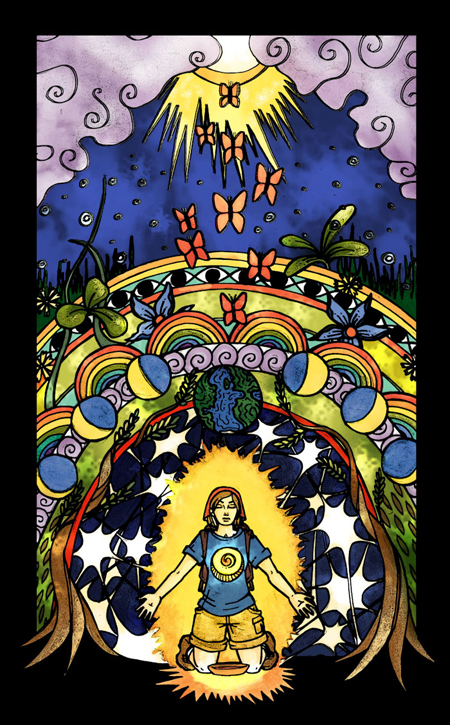 |
| Illustration: Emily Nisbet |
Diana felt called to Peru—by the spirit of a jungle plant, she says—to consume a thick, bitter potion known by a Quechua name, ayahuasca (eye-ya-WAH-ska). It's the leaves of a plain bush stewed for hours with the pounded pulp of a woody vine—ayahuasca translates to “vine of the soul/spirits.” Her hosts called it “the battery acid.” It wracked her with painful retching, and it transported her to a parallel universe filled with vibrating, light-saturated patterns and mythical monsters. She hoped the experience would lift a midlife malaise, renewing her for a new chapter in her life.
A hellish ordeal awaited Diana, but she endured. Ayahuasca eventually gave her a glimpse of heaven.
Thousands of Westerners have traveled Diana’s pilgrim’s path, exploring the fantastic realms unveiled by ayahuasca. A belief in the healing power of these ceremonies draws the seekers. Their faith grows out of stories brought back by those who have taken “the medicine.” They believe ayahuasca can reconnect them to nature and the divine—a primal union these wealthy city-dwellers lack.
Keenly aware of this First World need, Internet-savvy brokers of ayahuasca tourism advertise with promises of sacred visions and peace of mind. But can the ritual experience—with a cost that can exceed $2000—live up to the hype? The profiteers of this growing tourist trade and the seekers who sing ayahuasca's praises both would say there's only one way to know: Go meet the green goddess of Amazonia. Experience her awe-inspiring powers for yourself.
“Some people come away from drinking ayahuasca thinking it is a very real, living entity,” says anthropologist Christine Holman of Arizona State University. “The people that believe in her believe that very strongly. They call her Mother Ayahuasca.”
But experienced ayahuasca-drinkers say only Mother Ayahuasca knows whether she will reveal her nurturing side or instead unleash terror.
Surfing for a shaman
Ayahuasca entered Diana's life with uncanny timing. A stormy relationship with an abusive man had left her feeling wrecked. Diana had struggled with depression since childhood, and decades of talk therapy and pharmaceuticals had failed her.
 “I was in really dark, depressed spot,” Diana says. “I was saying to myself, 'Why do these patterns keep recurring? How am I going to get myself out of this?'” “I was in really dark, depressed spot,” Diana says. “I was saying to myself, 'Why do these patterns keep recurring? How am I going to get myself out of this?'”
Eleven years had passed, more or less in a fog. Diana needed a push to help her leave a job she hated—as a copy editor for a citywide magazine—and to escape what felt like an urban prison. Then she read Breaking Open the Head, a mass-market book by Daniel Pinchbeck. The book introduced her to Mother Ayahuasca and her earthly emissaries, the shamans of the Amazon.
Strictly applied, shamanism describes only the beliefs and practices of the nomadic Ural Altaic peoples of Siberia. Anthropologists now use the term more liberally, after research—far from central Asia—showed remarkable cultural similarities among many hunting or pastoral tribes. Shamans use psychoactive substances, music, or extreme physical stresses to visit alternate realities. On behalf of the communities they serve, shamans contact spirits populating this shadow world to effect changes in the ordinary world. People turn to shamans for cures of physical and mental illnesses, protection from malevolent spells and spirits, and divining the future.
The trackless jungle once kept ayahuasca shamanism hidden from anyone other than indigenous Amazonians. The vision-inducing brew had shaped the jungle-dwellers’ worldview for centuries by the time Columbus stumbled upon the New World. The end of that millennium came before word of ayahuasca spread far beyond academic circles and the counterculture.
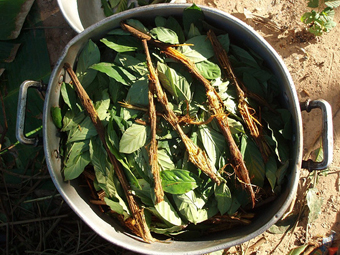 |
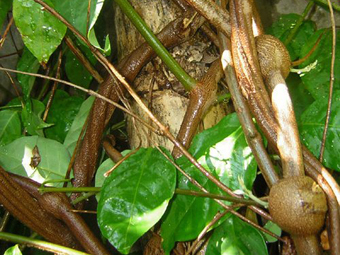 |
Photos: Awkipuma/Wikimedia Commons (left); Rafael Guimarães dos Santos/Wikimedia Commons (right) |
| An ayahuasca preparation (left), about to be brewed, with the beat-up pulp of the Banisteriopsis caapi vine (right) and the leaves of the Psychotria viridis bush. (Click on images to see larger photo.) |
By 2008, a simple Internet search immediately led Diana to social networking sites, like ayahuasca.com, packed with vivid and enthusiastic testimonials about the brew. A 2006 article in National Geographic Adventure, Kira Salak’s first-person account of ayahuasca healing, also appeared at the top of Diana's search results. Salak reported that ayahuasca sessions in Peru lifted her lifelong depression.
“It was as if a water-logged wool overcoat had been removed from my shoulders,” Salak wrote. “Feeling hope for the first time in my life. It was, without a doubt, miraculous.”
Upon reading Salak's words, Diana says, “I became obsessed. I didn't know how or where I would go, I just knew I would do it.”
 Salak's article became the most popular article in the publication's history, producing 20 times more reader response than any previous article. Anthropologists studying ayahuasca tourists say Salak's words inspire many to take their first steps on a quest for healing, but most of their experiences fail to measure up to her miracle. Salak's article became the most popular article in the publication's history, producing 20 times more reader response than any previous article. Anthropologists studying ayahuasca tourists say Salak's words inspire many to take their first steps on a quest for healing, but most of their experiences fail to measure up to her miracle.
“Her story has become the quintessential ayahuasca experience,” says anthropologist Evgenia Fotiou of the University of Wisconsin, Madison. Fotiou spent 18 months in Peru interviewing shamans, tour operators, and their clients. “A lot of popular articles focus on these radical transformations in just one ceremony. It happens very rarely.”
Selling spirituality
 The ayahuasca lodges contribute to the inflated expectations of its power. Christine Holman's research combined a summer of field work in Iquitos, Peru—the center of ayahuasca tourism—with a careful analysis of the websites that promote the ceremonies. The Internet presence of the six lodges she studied generates 50 to 90 percent of their business, Holman estimated. The ayahuasca lodges contribute to the inflated expectations of its power. Christine Holman's research combined a summer of field work in Iquitos, Peru—the center of ayahuasca tourism—with a careful analysis of the websites that promote the ceremonies. The Internet presence of the six lodges she studied generates 50 to 90 percent of their business, Holman estimated.
“Internet websites are the number-one way people find their shamans and set up their tours,” says Holman. “But those who control the medium control the message. They may represent the Amazon's plants, people, and places however they see fit.”
 Besides reassuring clients that the lodges provide for every comfort in a businesslike, professional manner, the tour websites include evangelical testimonials recounting ceremonies marked by healing, experiences of pure unconditional love, and revelations of profound wisdom. Besides reassuring clients that the lodges provide for every comfort in a businesslike, professional manner, the tour websites include evangelical testimonials recounting ceremonies marked by healing, experiences of pure unconditional love, and revelations of profound wisdom.
The sites use words like transformational, mystical, magical, sacred, ancient, and deep to describe the ceremonies, Holman found. If the lodge employs Peruvian or indigenous shamans, these locals usually appear in ethnic costuming. The text labels them as healers, teachers, or wise medicine men and women. The sites promise to connect tourists to primeval unspoiled nature as much as they promise profoundly positive spiritual or psychological changes. Lush pictures of verdant jungle, charismatic animals, and eco-friendly lodge facilities dominate the sites.
These marketing materials, the sensational articles, and word-of-mouth buzz about ayahuasca on the Internet send a flood of Westerners to Peru seeking “the medicine.” An annual Amazonian shamanism conference provides convenient one-stop shopping. The conference organizer, American ex-patriot Alan Shoemaker, carefully screens the men and women who offer their services in this shamanistic bazaar.
 |
Photo: Keith Rozendal |
Shipibo-Conibo embroidery, sold in the tourist market. (Click on image to see larger photo.) |
|
|
“It's like a market,” says Holman. “People drink ayahuasca with a number of different shamans and then report. It's like show and tell.”
Like the one-sided ayahuasca content on the Internet, positive testimonials from the conference crowd out reports of the realities and dangers of ayahuasca.
A remedy worse than the disease?
Diana was struck by the contrast between her own cautiously positive image of ayahuasca and that of locals she met in Iquitos who have ready access to the brew. They would only seek out a shaman after exhausting all other modern medical options. If they pay for an ayahuasca healing at all, only a tiny fraction of the tourist price changes hands.
“It seemed that the people there want nothing to do with it,” Diana says. “Whenever ayahuasca came up, they either thought I was nuts or they were really fascinated. 'You're going to pay someone to give this to you? You crazy white people!'”
Magical warfare looms large in Amazonian worldviews. Many curandero shamans tell curious anthropologists that Mother Ayahuasca first offers them the power to cause harm through possession, spiritual weapons, and turning nature against an enemy. The shaman must refuse this dark sorcerer path before ayahuasca offers healing powers.
“Sorcery is a huge part of shamanism, but Westerners are oblivious to that,” says Evgenia Fotiou. “An attempt has been made to extract this negative side of it, to make it more attractive. Nobody wants to go down there and be psychically attacked by a shaman.”
The locals' misgivings did not sway Diana's commitment to see what Mother Ayahuasca would offer. At the Temple of the Way of the Light, she sat in a circle of 20 other Westerners. The deafening nighttime chorus of the rainforest permeated the hut through its screen walls.
“You could tell the ceremony had started because the birds, frogs, and insects changed the way they started to sing,” Diana says.
 |
| Join Keith Rozendal on a video journey into the tribal customs of the Shipibo shamans. (Click on image to see video.) |
|
Seated at the center were Shipibo shamans who doled out “the battery acid.” They sang a capella songs called icaros to evoke emotions and summon spirits of the forest to the hut. These songs, which they say ayahuasca and other medicinal plants teach them, embody their power. Powerful shamans can recite hundreds of icaros.
The shamans delivered all of their care with liberal doses of smoke from hand-rolled mapacho cigars. They alternated the jungle tobacco smoke with sprays of Agua de Florida, a strong, cheap commercial perfume mixed with flower petals and other plants.
The floral baths, songs, and smoke can strongly shape the experiences of ayahuasca drinkers. They come to believe healing thoughts of the shamans penetrate them via the smoke and perfume. The icaros seem to strike resonant chords with the internal riot of energy sparked by ayahuasca.
“The medicine responds to the songs,” says Diana. “Your whole being is permeated by the sound, and the songs make the ayahuasca inside you respond.”
 Spanish-speakers nicknamed ayahuasca la purga (the purge). Each participant rides out the ceremony on a mattress beside a bucket—for vomit. The intensely bitter brew, tasting of bark and dirt, often triggers violent retching and dry heaves. Ceremony participants skip dinner, because explosive diarrhea sometimes accompanies the nausea. Sober assistants stand by to help incapacitated ayahuasca drinkers find the bathrooms. Surrounded by vomiters and fighting off her own violent nausea, Diana felt panic in several of her early sessions. Spanish-speakers nicknamed ayahuasca la purga (the purge). Each participant rides out the ceremony on a mattress beside a bucket—for vomit. The intensely bitter brew, tasting of bark and dirt, often triggers violent retching and dry heaves. Ceremony participants skip dinner, because explosive diarrhea sometimes accompanies the nausea. Sober assistants stand by to help incapacitated ayahuasca drinkers find the bathrooms. Surrounded by vomiters and fighting off her own violent nausea, Diana felt panic in several of her early sessions.
“It's like being on a battlefield,” she says. “People are dying around you.”
Behind closed eyes, she saw threatening visions and felt malevolent presences. “I pictured my neighbor as a dragon, breathing fire,” she says. “I went to some kind of white, massive, alien place. It was bleak, it was lonely, it was terrifying, it was cold.”
The surprising science behind shamanism
Given that ayahuasca will make one terribly nauseated—at a minimum—why do so many people emerge convinced of its medicinal powers?
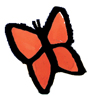 “In most traditional contexts, the purge might be seen as the most important part,” says anthropologist Michael Winkelman, recently retired from Arizona State University. Metaphorically, he says, ayahuasca drinkers believe the purge cleanses the body emotionally. Diana matter-of-factly assumed her fellow ayahuasca drinkers were “vomiting up their bull----.” “In most traditional contexts, the purge might be seen as the most important part,” says anthropologist Michael Winkelman, recently retired from Arizona State University. Metaphorically, he says, ayahuasca drinkers believe the purge cleanses the body emotionally. Diana matter-of-factly assumed her fellow ayahuasca drinkers were “vomiting up their bull----.”
“These plants can bring to the surface trauma you've repressed,” says Winkelman. “So a lot of the nausea has to do with the emotions you revisit.”
Studies of the biochemistry and pharmacology of ayahuasca brews raise some tantalizing leads about their potential benefits. The vine component (Banisteriopsis cappi) contains strong monoamine oxidase (MAO) inhibitors. Modern antidepressants contain drugs with similar effects. The brew also contains N,N-Dimethyltryptamine (DMT), a compound that strongly activates networks of serotonin neurons, a common strategy for attacking major depression. Remarkably, the psychedelic DMT in the leaves of the chacruna bush (Psychotria viridis) would have no effect if they weren't ingested along with the ayahuasca vine's MAO inhibitors. Scientists can only guess how hunter-gatherers discovered this complex jungle plant synergy.
 These traits, as well as the global spread of ayahuasca use, have spurred scientific tests of ayahuasca’s safety and efficacy. Studies have looked at the brew’s effect on a range of conditions, including addictions. But those possessing ayahuasca without a researcher's license for DMT risk prison sentences in the U.S. and many other Western countries. This makes Peru one of the only places an ayahuasca seeker can avoid legal risks. These traits, as well as the global spread of ayahuasca use, have spurred scientific tests of ayahuasca’s safety and efficacy. Studies have looked at the brew’s effect on a range of conditions, including addictions. But those possessing ayahuasca without a researcher's license for DMT risk prison sentences in the U.S. and many other Western countries. This makes Peru one of the only places an ayahuasca seeker can avoid legal risks.
Winkelman says the pilgrimage to Peru and the ceremonies experienced there by ayahuasca seekers imbue the journey with special power.
 “Ritual—everyone in a group following the same pattern—is a very powerful way of focusing attention, focusing consciousness and linking people at a very deep psychological level,” he says. Winkelman's research links shamanistic practices seen around the world to evolved traits of the human brain and body. “When you take these substances with a supportive set [expectations for a drug] and setting, they induce a set of therapeutic responses inside of us,” he maintains. “Ritual—everyone in a group following the same pattern—is a very powerful way of focusing attention, focusing consciousness and linking people at a very deep psychological level,” he says. Winkelman's research links shamanistic practices seen around the world to evolved traits of the human brain and body. “When you take these substances with a supportive set [expectations for a drug] and setting, they induce a set of therapeutic responses inside of us,” he maintains.
An eight-hour orgasm
Despite Diana's initial ayahuasca panics, she kept returning to the circle over several more nights until the final ceremony. When she left the hut to weather an especially difficult wave of nausea and vertigo, the experience shifted.
“I felt it come for me,” she says. “A great light entered me and I saw the light leaving me and flying around in the trees. It felt entirely blissful—orgasmic but far, far beyond that.”
For the next several hours, Diana's uterus vibrated with intense pleasure. She collapsed in a chair to ride out the flood of arousal. She believes ayahuasca activated her body's capacity for pleasure to vividly impress a lesson upon her. “I asked Ayahuasca a question,” she says. “The answer it gave me was 'Your body knows. Life is not something to be afraid of. You are allowed to have fun.'”
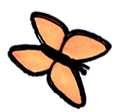 Diana says the undeniable visceral feelings helped to overcome her resistance to the insight, rooted in decades of family and cultural influences. “I come from a family where we didn't touch each other,” she says. “I didn't know how to manage and accept pleasure. I believed if something makes you feel good, it won't teach you anything.” Diana says the undeniable visceral feelings helped to overcome her resistance to the insight, rooted in decades of family and cultural influences. “I come from a family where we didn't touch each other,” she says. “I didn't know how to manage and accept pleasure. I believed if something makes you feel good, it won't teach you anything.”
When she felt she could stand again, Diana found two other participants also on good trips. They played together deep into the morning, trailing glow worms and laughing. Diana's bliss slowly faded, days later.
Romantic notions
Long after the ceremonies, Diana can still connect with the feeling of the ayahuasca working within her—usually during transitions in and out of sleep. The lengthy afterglow from her final ceremony has aided her mission to make changes in her life and character in response to the blissful insight.
“I don't think I'm done,” she says, four months after her time in Peru. “Without a doubt, ayahuasca started something. Now, I'm definitely in re-integration land.”
She's been in a gift-giving mood, distributing small squares of Shipibo embroidery to cultivate intimacy with old and new friends who ask to hear her story. Occasionally, Diana feels her fresh ayahuasca insight clashes with a character shaped by a lifetime of inhibition. But regaining the comforts and security of her old life holds little temptation. She doesn't know what comes next, but she says her life and her outlook have changed fundamentally.
“I needed a rite of passage,” she says. “The ayahuasca ritual had enough weight to it to actually mean something.”
The names people give to ayahuasca reveal their attitudes. A follower of “Mother Ayahuasca” projects selfless and loving traits onto a deity that inhabits the vine. Many Western ayahuasca drinkers, including Diana, prefer to apply a more naturalistic metaphor—“the medicine.” These converts don't adopt a mystical shamanic worldview, but they bristle when they hear ayahuasca called a psychedelic drug or hallucinogen. They won't have ayahuasca visions dismissed as mere delusions or entertaining light shows. These seekers believe ayahuasca delivers a powerful jolt to the psyche, triggering healthy changes in a person's life.
 “They want a radical transformation of the self, finding insight or some direction in their life,” says Evgenia Fotiou. “They really hope this amazing thing will happen in just this one week. It's definitely quicker than psychotherapy, but it's not as quick as they want.” “They want a radical transformation of the self, finding insight or some direction in their life,” says Evgenia Fotiou. “They really hope this amazing thing will happen in just this one week. It's definitely quicker than psychotherapy, but it's not as quick as they want.”
Those Westerners who return with especially firm convictions about the reality of the spirit world may call ayahuasca an entheogen—a substance that causes one to experience the divine directly.
“They have a romantic notion that they will find a lost spirituality in this other culture,” says Fotiou. “They feel that Western culture has lost touch with nature and this type of direct spiritual experience.”
Michael Winkelman argues that these feelings reflect a true lack of the sacred in many people's lives in rich, crowded cities. He says ayahuasca and shamanism draw many seekers from among these ranks. “There truly is a spiritual void and hunger that makes people more attuned to the possibilities that exist in other cultures,” he says. “I think Western society was long overdue for a shift to more spiritual practices and concerns.”
Given the buzz about ayahuasca, and its continued ban in Western countries, these pilgrimages surely will grow more popular. The unbalanced word-of-mouth online, and converts to ayahuasca's cause, should expand the trade. However, as Fotiou notes, some of the unpleasant realities and dangers have begun to enter online discussions.
Diana takes care to caution those who want to repeat her orgasmic engagement with ayahuasca. “For all of the goodness and love I felt, it always felt unsafe,” says Diana. “I felt something closer to awe than any cozy feeling.”
 Of course, many people who discover that one can book a trip to ayahuasca-space just as easily as a cruise to Acapulco will still decide it holds no appeal. La purga raises a barrier that only the most driven seekers will cross. No ayahuasca drinker knows whether heaven or hell awaits them. Mother Ayahuasca may decide that they need to face demons many times before their own blissful breakthrough comes, if at all. Of course, many people who discover that one can book a trip to ayahuasca-space just as easily as a cruise to Acapulco will still decide it holds no appeal. La purga raises a barrier that only the most driven seekers will cross. No ayahuasca drinker knows whether heaven or hell awaits them. Mother Ayahuasca may decide that they need to face demons many times before their own blissful breakthrough comes, if at all.
Like many other ayahuasca drinkers, Diana wants to make the medicine more widely known, despite the mixed bag of terror and joy it handed her.
“I wish I could just take everyone there, especially my friends with depression, addictions, or who just aren't happy,” she says. “Try this, I'll hold your hand. It's hard, but maybe you'll break through and not spend the next five years f---ing miserable.”
Story © 2011 by Keith Rozendal. For reproduction requests, contact the Science Communication Program.
Top
Biographies
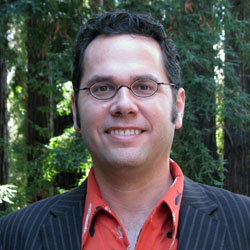 Keith Rozendal Keith Rozendal
B.A. (psychology) Rice University
Ph.D. (social psychology) University of California, Santa Barbara
Internship: "Big Picture Science" radio program, SETI Institute (Mountain View, CA)
For half my life, I thought mine was the last generation of Homo sapiens. My school notebooks, quoting despairing punk-rock lyrics and sprouting sketches of mushroom clouds, told of my resignation to a future truncated by nuclear war.
How did I maintain an enthusiasm for studying nature, history, psychology, and politics? In part, my participation in people's history—collective action seeking peace and justice—sustained me. Along the way came this revelation: science, if driven by humane values, can emerge as Martin Luther King Jr.'s “creative force in this universe, working to pull down the gigantic mountains of evil.”
Ever since, I’ve sought evidence of this blooming. Through my writing, I will bear witness whenever I see the better angels of human nature inspiring those who use scientific discovery to craft a hopeful future.
. . . . . . . . . . . . . . . . . . . . . . . . . . . . . . . . . . . . . . . . . . . . . . . . . . .
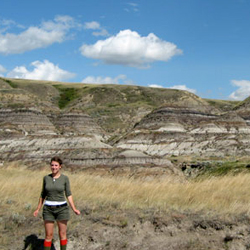 Emily Nisbet Emily Nisbet
B.A. (anthropology) Eastern Washington University
Internships: Mission San Juan Bautista Museum, San Juan Bautista, CA; Orkney Research Centre for Archaeology, Kirkwall, Orkney
Emily Nisbet has had lifelong interests in history, culture and art. She received her bachelor’s in anthropology from Eastern Washington University while interning with Archaeological and Historical Services, drawing scientific schematics of pipes, projectile points and other artifacts. Working with these materials, she saw an opportunity to combine her interests in scientific illustration. She hopes to continue to use diagrams, maps and illustrations to clarify sometimes baffling historical information.
Top |

